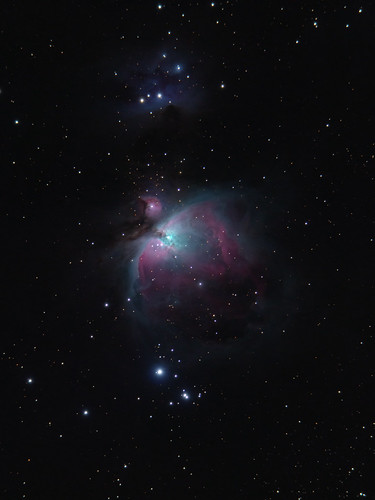28 January 2019, 19:15 – 21:15
The first clear, moon-free night in over a month. Cold, but not bitter. Light wind. Good transparency. Scope seemed to take longer to reach ambient temperature; best views were at 133x (9mm Nagler).
M45, Pleiades, Taurus
Viewing at 50x (24mm Panoptic); Merope nebula easier to see now I’ve got my bearings: visible as a misty patch fanning out from Merope to the south, framed by dark “lanes” on either side. The nebulosity in the Pleiades is much easier to see when you know which stars aren’t involved in it, such as the distinctive line of stars trailing from Alcyone.
NGC 2024, Flame Nebula in Orion
Tough to see because of the glare from Alnitak. Better contrast at 133x, but more condensed at 50x. IC 434 (the glow behind the Horsehead) was only suggested at best, but NGC 2023 clearly visible as a small patch of light surrounding a star, swelling with averted vision.
M78, reflection nebula in Orion
Twin stars immersed in a cloud, like headlights shining through fog. Some mottled structure apparent with averted vision, sharp cut-off on northern side – NGC 2071 visible on the other side of this dark gap: smaller and fainter than M78, no structure visible.
M42, Great Nebula in Orion
Breathtaking spectacle; can appreciate it even more now I’ve photographed it (above). 133x gave the best view for contrast and detail even though it was too big for a single fov. Intricate detail seen with direct and averted vision, including nebulosity within the “fish-mouth” area. The dark lane between M42 and M43 contrasts nicely with the fainter nebulosity beyond the Huygens region, illustrating that the nebula is much more extensive than its initial bird-like appearance implies. Brighter arc seen on opposite side of cavity, corresponding with sculpted section seen in photos.
Trapezium stars E and (to a lesser extent) F were oddly easier to see at 133x than 240x (clearly not a night for high-power viewing).
The southern wing of the nebula was remarkable: long and irregular but with well defined edges, like a ribbon of light. The adjacent part of the nebula was not the same colour as the ribbon, but hard to say what exactly other than “not green”. Maybe the slightest hint of violet, but it was right on the limit of perception.
The Ultrablock significantly filled out the northern half of the nebula and made the Huygens region seem more boxy, sharper-edged, but otherwise not that much improvement (not a criticism of the filter; just that M42 is bright enough not to need it.)
M43, emission nebula in Orion
Comma-shaped haze surrounding single star. Dark lane visible with averted vision.
Also quick looks at NGC 1981 open cluster and the Running Man Nebula, the latter’s gauzy appearance clearly more akin to the Merope nebula than M42. Averted vision suggested a “bite” taken out of the southern edge.
NGC 2174-5, open cluster + emission nebula, Orion
Obvious and surprisingly large patch of light, somewhat elongated. Nebulosity seemed concentrated around central star, but no obvious cluster, at least not at low magnification.
NGC 2392, Eskimo Nebula, Gemini
Lovely winter planetary. Small, but immediately obvious fuzzy star at 50x. Nearby star helps confirm its nature. Central star visible at 133x. Averted vision showed two concentric rings of material. Seemed more blue-green than typical grey-green, but difference is subtle; certainly nowhere near as blue as the Snowball in Andromeda. Ultrablock filter improved contrast but not really required for such a bright nebula.
NGC 2264, Christmas Tree Cluster, Monoceros
Very pretty (and “right” way up for a change). Very bright blue star at “base” – seemed to be surrounded by haze, but hard to tell if it was genuine nebulosity. No obvious sign of the Cone Nebula, but while sweeping south I soon arrived at…
NGC 2261, Hubble’s Variable Nebula, Monoceros
Small and bright (but obvious even at 50x) fan-shaped nebula. 133x showed bright condensation at apex, but I think it would take a still higher power to show significant detail.
NGC 2237-9 (Rosette Nebula), surrounding open cluster NGC 2244 in Monoceros
Took a while to find – the lack of bright stars in Monoceros (not to mention the ever-present lure of Orion) make it a challenge to navigate via star-hopping. Appearance: Boxy cluster surrounded by large, diffuse nebula – too large for fov even at 50x. Brighter arc on northern side. Potential photographic target for TV60.
While sweeping across Monoceros I stumbled upon what I later identified as NGC 2301 – a distinctive rich cluster, well worth a return visit (if I can find it again).
Quick looks (cold, condensation and tiredness starting to play a part):
M97 (Owl Nebula), planetary nebula in Ursa Major
Large and faint (the opposite of the Eskimo). The Ultrablock dramatically improved the view. Hint of dark cavities (the owl's eyes).
M108, galaxy in Ursa Major
Faint sliver of light, with field star imposed over centre. Another potential photo target (pairing with Owl Nebula).
M81, M82, galaxies in Ursa Major
Not as impressive as previous observations – a sign it was time to pack up for the night.


No comments:
Post a Comment